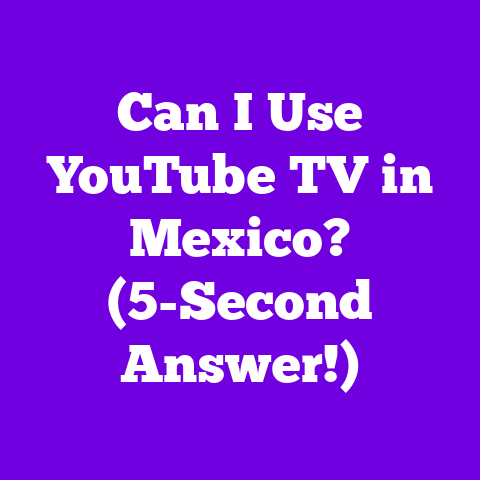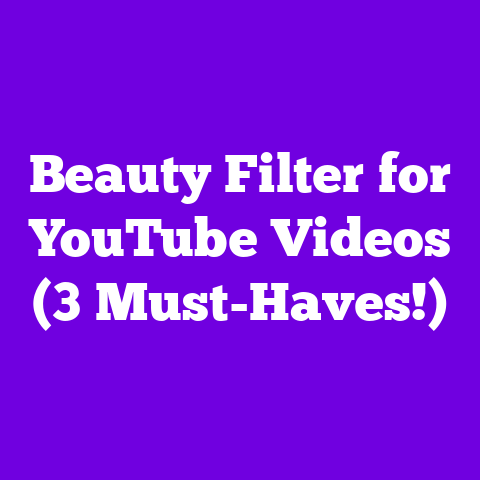Adblock for YouTube Google Chrome (2-Second Tweak!)
(2-Second Tweak!) for 2025
Imagine you’re deep into an awesome tutorial or vibing to your
favorite music, and BAM!
An ad pops up.
Annoying, to say the
least.
For us creators, it’s a double-edged sword.
Ads bring in
revenue, but they can also drive viewers away.
It’s a constant
balancing act.
That’s where ad blockers come in.
They offer a way to enjoy
YouTube without the interruptions, and I’m going to share a
super-simple tweak to get you there.
This article is all about that sweet, ad-free viewing experience
on YouTube using Google Chrome.
I’ll dive into how ad blockers
work, their impact on creators, and a super-quick way to set one
up.
I’ll also explore the ethical side of things and other options like YouTube Premium.
Ready to reclaim your YouTube experience?
Let’s get started!
Section 1: Understanding Adblock Technology
What is Adblock?
So, what exactly is an ad blocker?
Simply put, it’s a piece of
software designed to prevent ads from appearing on websites,
including YouTube.
These tools work by identifying and blocking the code that
displays ads.
Think of them as digital bouncers, keeping unwanted
guests (ads) out of your party (YouTube viewing).
Most ad blockers are browser extensions, meaning they integrate
directly into your web browser, like Google Chrome.
Once
installed, they automatically filter out ads as you browse.
They use filter lists, which are essentially huge databases of ad
server URLs and ad-related code.
When a website tries to load an
ad from one of these servers, the ad blocker steps in and says,
“Nope, not today!”
The Evolution of Adblocking
Ad blocking has been around for longer than you might think.
The
first ad blockers emerged in the early 2000s as pop-up ads became
increasingly intrusive.
Over the years, ad blockers have become more sophisticated,
adapting to new ad formats and techniques.
They’ve also become
more user-friendly, with simple installation processes and
customizable settings.
YouTube has always been a key battleground in the ad-blocking
wars.
As YouTube’s advertising strategies have evolved, ad
blockers have had to adapt to stay effective.
We’ve seen YouTube crack down on ad blockers, and ad blocker
developers respond with updates to bypass these measures.
It’s an
ongoing cat-and-mouse game.
Statistics and Trends
Ad blocking is a widespread phenomenon.
According to Statista,
nearly 30% of internet users worldwide use ad blockers.
That’s a
huge chunk of the online population!
While specific numbers for YouTube ad blocking are harder to come by, it’s safe to assume that a significant portion of YouTube users employ ad blockers.
Why? Because let’s face it, nobody loves being bombarded with ads.
Looking ahead to 2025, I expect ad blocking to remain popular.
As online advertising becomes more intrusive and personalized, more
people will likely turn to ad blockers for a cleaner browsing
experience.
However, YouTube and other platforms will likely continue to experiment with new ad formats and anti-ad-blocking measures, so the battle will continue.
Ad Blocking Reach Worldwide from 2014 to 2027 (in millions of internet users)
Source: Statista
Section 2: The Impact of Ads on YouTube Creators
Content Creator Perspective
Okay, let’s talk about how ads affect us content creators.
On one
hand, ads are a major source of revenue.
They allow us to keep
creating the content you love.
The more ads that run on our videos, the more money we make.
Simple, right?
Well, not exactly.
Excessive ads can lead to viewer fatigue and
decreased watch time.
If viewers are constantly interrupted by ads,
they’re more likely to click away and find something else to watch.
This can hurt our channel’s performance in the long run.
YouTube’s
algorithm favors videos with high watch time and engagement, so
anything that drives viewers away is bad news.
I’ve spoken to many creators who are constantly trying to find the
right balance between monetization and viewer experience.
It’s a
tough call.
Some creators have experimented with fewer ads or shorter ads to
improve viewer retention.
Others have explored alternative
monetization methods, like sponsorships or merchandise.
Viewer Experience
Now, let’s look at things from the viewer’s perspective.
Ads can be
a major annoyance, especially when they interrupt the flow of a
video.
Imagine you’re watching a suspenseful scene in a movie review, and
suddenly, an ad for toothpaste pops up.
It completely breaks the
immersion.
Too many ads can also make viewers feel like they’re being exploited.
They might start to resent the creator for “selling out” or
prioritizing profit over content quality.
This can lead to a loss of subscribers and a decline in overall
engagement.
Viewers might also be less likely to share or recommend
videos with excessive ads.
Case Studies
Let me share a couple of real-world examples.
I know a gaming
channel that saw a significant drop in viewership after YouTube
increased the number of ads on their videos.
Viewers complained that the ads were too frequent and intrusive, and
many of them switched to watching other channels.
The creator had to
rethink their monetization strategy to win back their audience.
I also heard about a vlogger who lost a major sponsorship deal
because their videos had too many ads.
The sponsor felt that the
ads were detracting from their brand’s message and decided to pull
out.
These examples highlight the importance of finding a balance between
monetization and viewer experience.
Ads are necessary, but they
shouldn’t come at the expense of alienating your audience.
Section 3: The 2-Second Tweak Explained
Alright, let’s get to the good stuff!
I’m going to show you how to
install an ad blocker on Google Chrome in just a few seconds.
This tweak is super simple and effective, and it will make your YouTube viewing experience much more enjoyable.
Step-by-Step Guide:
-
Open Google Chrome: Make sure you’re using the Chrome browser on your computer.
Visit the Chrome Web Store: Type “Chrome Web Store” into the search bar and click on the first result.
Alternatively, you can directly typechrome.google.com/webstorein the address bar.Search for an Ad Blocker: In the search bar at the top of the Chrome Web Store, type “AdBlock” or “Adblock Plus”.
I personally use “AdBlock” and recommend it.Choose Your Ad Blocker: Select your preferred ad blocker from the search results.
Make sure to choose a reputable one with good reviews.-
Add to Chrome: Click the “Add to Chrome” button next to the ad blocker you’ve chosen.
Confirm Installation: A pop-up window will appear asking you to confirm the installation.
Click “Add extension”.
That’s it!
You’ve successfully installed an ad blocker on Google
Chrome.
Now, when you visit YouTube, you shouldn’t see any more
ads.
(Visual Aid: Screenshot of the Chrome Web Store with the “Add to Chrome” button highlighted)
(Visual Aid: Screenshot of the confirmation pop-up window)
Common Issues and Troubleshooting
Sometimes, things don’t go exactly as planned.
Here are a few
common issues you might encounter and how to fix them:
Ad Blocker Not Working: Make sure the ad blocker is enabled in your Chrome extensions.
Go tochrome://extensions/in your address bar and check if the ad blocker is turned on.YouTube Detects Ad Blocker: YouTube is getting smarter at detecting ad blockers.
If you see a message saying “Ad blockers violate YouTube’s Terms of Service,” try updating your ad blocker to the latest version.Website Not Loading Properly: In rare cases, ad blockers can interfere with website functionality.
If a website isn’t loading correctly, try temporarily disabling the ad blocker for that site.
If you’re still having trouble, check the ad blocker’s support forums or contact their customer support team for assistance.
Section 4: The Legal and Ethical Considerations of Adblocking
Understanding the Debate
Ad blocking is a controversial topic.
On one side, you have users
who want a clean, ad-free browsing experience.
On the other side,
you have content creators and websites that rely on advertising
revenue to survive.
The debate boils down to a fundamental question: Who has the right
to control the viewing experience?
Users argue that they have the
right to block ads if they choose to.
They point to the fact that ads can be intrusive, annoying, and even harmful (in the case of malware-laden ads).
Content creators and websites argue that ad blocking is essentially
stealing their content.
They claim that users are enjoying their
work without contributing to its upkeep.
Ethics of Adblocking
The ethics of ad blocking are complex.
There’s no easy answer.
Some
people argue that ad blocking is morally wrong because it deprives
content creators of revenue.
They believe that users have a responsibility to support the content they enjoy, even if it means watching ads.
Others argue that ad blocking is a form of self-defense.
They claim
that websites have become too aggressive with their advertising,
bombarding users with irrelevant and intrusive ads.
They believe that users have the right to protect themselves from these practices, even if it means using ad blockers.
Ultimately, the decision of whether or not to use an ad blocker is a
personal one.
There’s no right or wrong answer.
Future Considerations
Looking ahead, I expect the debate over ad blocking to continue.
As
online advertising becomes more sophisticated, ad blockers will have
to adapt to stay effective.
YouTube and other platforms will likely continue to experiment with new ad formats and anti-ad-blocking measures.
We might also see the rise of new business models that don’t rely on
traditional advertising.
For example, some websites are experimenting
with subscription models or micropayments.
Ultimately, the future of ad blocking will depend on how these
various factors play out.
It’s a dynamic and evolving landscape.
Section 5: Alternatives to Adblocking
YouTube Premium
If you want an ad-free YouTube experience without using an ad
blocker, YouTube Premium is a great option.
For a monthly fee, you
get access to ad-free viewing, as well as other perks like offline
downloads and background playback.
YouTube Premium also supports the creators you love.
When you watch
their videos with YouTube Premium, they still get paid.
It’s a win-win situation.
You get an ad-free experience, and
creators get the revenue they need to keep creating awesome content.
Content Creator Solutions
As content creators, we also have a role to play in addressing the
issue of ad blocking.
We can try to create ads that are less
intrusive and more relevant to our audience.
We can also explore alternative monetization methods, like sponsorships, merchandise, or crowdfunding.
By diversifying our revenue streams, we can reduce our reliance on traditional advertising and create a more sustainable business model.
Community Feedback
I’ve seen a wide range of opinions on ad blocking within the YouTube
community.
Some viewers are staunch supporters of ad blockers, while
others are more ambivalent.
Some creators are understanding of ad blocking, while others are frustrated by it.
Ultimately, the best approach is to listen to your audience and try to find a solution that works for everyone.
Conclusion
Recap of Key Points
Okay, let’s recap what we’ve covered.
We’ve talked about the
importance of ad-free viewing experiences on YouTube, the impact of
ads on creators, and a super-simple tweak to install an ad blocker
on Google Chrome.
We’ve also explored the ethical considerations of ad blocking and alternative options like YouTube Premium.
Future Outlook
Looking ahead, I expect ad blocking to remain a popular tool for
YouTube users.
As online advertising becomes more intrusive, more
people will likely turn to ad blockers for a cleaner browsing
experience.
However, YouTube and other platforms will likely continue to
experiment with new ad formats and anti-ad-blocking measures.
It’s
an ongoing battle.
Ultimately, the future of ad blocking will depend on how these
various factors play out.
It’s a dynamic and evolving landscape.
Call to Action
Now, I want to hear from you!
What are your experiences with ads on
YouTube?
Have you tried the 2-second tweak I shared?
Content creators, how are you dealing with ad blocking trends?
What
strategies are you using to maintain viewer engagement?
Share your thoughts and experiences in the comments below!
Let’s
start a conversation and learn from each other.





